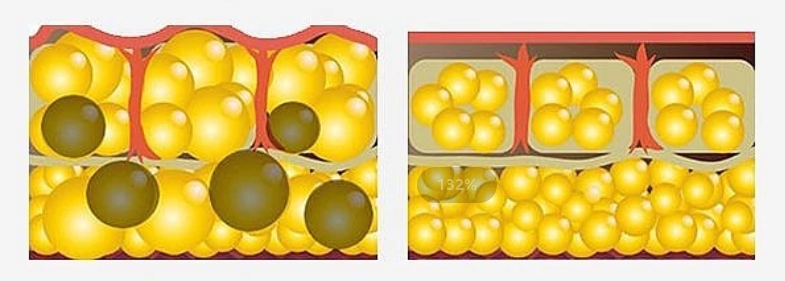
What happens to adipocytes when we lose weight intensively?
2024-03-05 10:56
APOPTOSIS OR NECROSIS? OR MAYBE LIPOLYSIS?
Have you ever wondered what happens to adipocytes (fat cells) when we intensively “lose weight”? Meanwhile, there are
three possible scenarios for the development of events. And the choice of hardware impact depends on which one we want
to use.
OPTION #1. LIPOLYSIS. Everything is very simple with him. Adipocytes have so-called alpha receptors, which are responsible
for the accumulation of fatty inclusions in adipose tissue cells. And there are beta receptors, which, on the contrary, activate
the same lipolysis - the breakdown of fat into water, glycerol and fatty acids. Is there any doubt that alpha receptors are
hundreds of times more active by nature!
When we stimulate LIPOLYSIS, we activate beta receptors in one way or another and trigger the process of fat breakdown
in the fatty inclusions of adipocytes. At the same time, the fat cells themselves do not suffer, they continue their measured
life path and wait for the moment when it will be possible to make new stocks for a rainy day.
What hardware techniques activate lipolysis? These are myostimulation, vacuum, partially RF lifting, vibration massage,
ultrasonic phonophoresis, lipolaser. Indirectly acting lipolytics in hardware cosmetics, body wraps and injectable preparations
also stimulate lipolysis.
And now the most interesting part, namely the methods of destroying adipose tissue.

OPTION No. 2. NECROSIS. Yes, it is the necrosis of adipocytes that is associated with the use of direct-acting lipolytics in
injection preparations. Necrosis processes are also triggered by cavitation and, in small quantities, RF body lifting. The
process of traumatic destruction of fat cells begins. The cell membrane (membrane) begins to collapse, the cell increases
in size, its nucleus swells, the breakdown of intracellular structures and DNA begins, and an inflammatory process begins
in the tissue, leading to the formation of fibrosis in the future. In addition, decay products in the form of toxins enter the
intercellular space, giving the body a signal that it has just suddenly lost a noticeable amount of living, functional, highly
specialized tissue.
The consequences of an overdose can be very unpleasant. Cell breakdown products can be toxic to the body and overload it.
The body can start the process of compensating for the loss and give a signal to reserve stem cells to quickly “mature” into
adipocytes and take the place of dead comrades. In addition, young adipocytes are capable of dividing.
OPTION #3. APOPTOSIS. Now this is the most interesting part.
Apoptosis is a genetically programmed cell death, which leads to their “careful” disassembly and removal. The morphological
signs of this active process are changes in the cell membrane ("loosening" of vesicles, so-called apoptotic bodies), disintegration
of the cell nucleus, compaction of chromatin and DNA fragmentation. Cells that have undergone apoptosis are recognized by
macrophages and other phagocytic cells and are quickly consumed. It is very important that during apoptosis an inflammatory
process does not develop and there is no intoxication of the body.When we stimulate APOPTOSIS locally, in the area of fat depots,
we trigger the very process of “natural” death of fat cells, without causing stress to the body. As a result, the volumes of the
processed local fat depot change irreversibly; it is not able to accumulate the previous reserves of fatty inclusions, and the volumes
disappear.
Get the latest price? We'll respond as soon as possible(within 12 hours)







